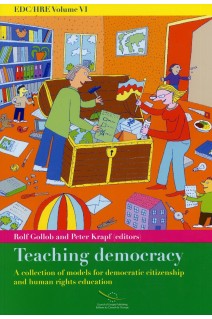



This teachers' manual contains a collection of exercises and models for Education for Democratic Citizenship (EDC) and Human Rights Education (HRE) in schools as well as in non-formal settings of education. These teaching models provide the framework to encourage students to become active by offering examples and inroads to understanding general principles of democracy and human rights. Many exercises are adaptable for different age groups, as the level of reflection may vary.The wide variety of approaches reflects the fact that authors from all parts of Europe have contributed to this book. They have drawn on different sources and traditions of teaching and learning, and have selected models that they know through practical experience and testing in class. However, there is a shared understanding of EDC/IIRE that runs through every part of this book: in EDC/HRE, the method carries the message. This manual offers the users the chance to select and to try out different traditions and approaches to Education for Democratic Citizenship and Human Rights Education.
Introduction
Chapter 1 - Building up classroom atmosphere
Introduction
1.1. Matching cards
1.2. Rights, responsibilities and rules in the classroom
1.3. Identity coat of arms
1.4. A bouquet of flowers
1.5. Chinese sticks
Chapter 2 - Clarifying values
Introduction
2. 1 . The raft game
2.2. Value systems
2.3. Philosophy of life
Chapter 3 - Getting to know human rights
Introduction
3.1. The human rights poster
3.2. The strings
3.3. The human rights tree
3.4. The balloon ride
3.5. Wants and needs
3.6. The treasure box
Chapter 4 - Perceiving others
Introduction
4. 1 . All different, all equal
4.2. Difference
4.3. True and false
4.4. First impressions
4.5. We all have prejudices
4.6. We are all equal, but some are more equal than others
4.7. The tourists
4.8. Globingo: "A human being is part of the whole world"
Chapter 5 - Making justice work
Introduction
5.1. It's not fair
5.2. The exception
5.3. The jigsaw puzzle
5.4. The role of law
5.5. Perspectives on justice
Chapter 6 - Understanding political philosophy
Introduction
6.1. Basic concepts of political thought
6.2. Attitudes to power
6.3. If I were a magician
Chapter 7 - Taking part in politics
Introduction
7.1. The wall of silence
7.2. My feelings about dictatorship
7.3. Questionnaire on attitudes to change
7.4. The planning project
7.5. We and the world
7.6. Should we take part in politics?
7.7. How does government affect your life?
7.8. Ways of participating in democracy
7.9. The policy cycle
Chapter 8 - Dealing with conflict
Introduction
8.1. Win-win solutions
8.2. A structured approach to conflict resolution
8.3. Family and peer conflict
8.4. Brainstorming session on conflict and peace
8.5. The statues
8.6. Punishment versus positive conflict resolution
8.7. Minorities
8.8. Images of war and peace
Illustrations
Introduction
1. Building up classroom atmosphere
2. Clarifying values
3. Getting to know human rights
4. Perceiving others
5. Making justice work
6. Understanding political philosophy
7. Taking parts in politics
8. Dealing with conflict
Télécharger un extrait (1000)

This teachers' manual contains a collection of exercises and models for Education for Democratic Citizenship (EDC) and Human Rights Education (HRE) in schools as well as in non-formal settings of education. These teaching models provide the framework to encourage students to become active by offering examples and inroads to understanding general principles of democracy and human rights. Many exercises are adaptable for different age groups, as the level of reflection may vary.The wide variety of approaches reflects the fact that authors from all parts of Europe have contributed to this book. They have drawn on different sources and traditions of teaching and learning, and have selected models that they know through practical experience and testing in class. However, there is a shared understanding of EDC/IIRE that runs through every part of this book: in EDC/HRE, the method carries the message. This manual offers the users the chance to select and to try out different traditions and approaches to Education for Democratic Citizenship and Human Rights Education.
Attention, en vertu de nos conditions générales de vente, l'achat des PDF/epub est réservé aux particuliers.
